
What works to reduce foodborne pathogens in poultry parts? Dr. Bryan Miller, vice president of quality assurance and food safety, Wayne Farms, described the latest findings on Salmonella intervention strategies in poultry production and processing during the Poultry Processor Workshop.
Treating pre-chiller water with acids, washing second-processing belts with ozonated water and keeping litter dry on the farm are among the most effective and/or promising interventions to reduce foodborne pathogens such as Salmonella in poultry parts. But there is no silver bullet for eliminating Salmonella in poultry parts and a multi-step approach throughout live production and processing is necessary to reduce Salmonella contamination.
“Live production, first processing and second processing operations all have impacts on Salmonella prevalence on chicken parts,” Miller said. “Many things affect the effectiveness of foodborne pathogen reduction practices in any operation, and not all practices are effective in all establishments.”

Bryan Miller, vice president of quality assurance and food safety, Wayne Farms, discussed Salmonella reduction in poultry parts.
Nonetheless, certain interventions for Salmonella contamination are emerging as most effective and/or promising in U.S. poultry industry trials, he said.
Miller is a member of the National Chicken Council’s Second Processing Working Group, which shares data, ongoing research, and successes and failures about techniques to reduce Salmonella prevalence on chicken parts. Over the last two years, the group has collected over 25,000 microbial samples from poultry parts at 77 processing plants.
He recommended implementing microbiological interventions for foodborne pathogen control as far up in the process as possible. Don’t depend solely on chemical antimicrobials in the final processes such as the poultry chiller, but instead implement controls in live production, scalding, the New York washer, sanitary dressing and pre-chilling.
Live-production interventions for Salmonella
Reducing foodborne pathogen loads in breeder houses, hatcheries and broiler houses can be achieved by the following means:
- Sanitation in hatcheries, including the use of formaldehyde wicks
- Proper biosecurity and house cleaning
- Pest control inside and outside of barns and processing plants
- Appropriate feed and water programs, including periodic application of sanitizers in poultry drinking water systems
Hatchery sanitation measures such as the use of formaldehyde wicks not only reduce Salmonella as a potential foodborne pathogen but also result in lower first-week mortality in broiler flocks, Miller said.
Wayne Farms’ analysis of Salmonella prevalence in flocks by grower has shown that flocks from some farms are almost never positive. Site visits revealed those farms frequently had superior litter management, particularly keeping the litter dry.
It has been found that poultry house litter management is effective in reducing Salmonella loads in flocks at the time of processing. Keeping litter dry (below 25 percent moisture) is not only beneficial for reducing Salmonella in the flocks but also promotes healthier and higher-quality chicken paws. What’s more, producers are applying poultry litter amendments to effectively reduce Salmonella loads in poultry while lowering ammonia in growing houses to promote flock health.
First-processing interventions for Salmonella
Miller named first-processing interventions that can be effective in reducing Salmonella in poultry:
- Pre-operation swabs used to establish the production “lot”
- Multiple intervention methods used in a coordinated manner (high pH in scalder, followed by low pH in New York washer, and high pH in chiller)
- Pre-scalder brushes
- Proper scalder and picker maintenance and cleaning
- Intervention in New York wash cabinet
- Removing cropper to avoid tearing of the scapula and ribs
- Maintain pre-chiller water quality
- Maintain chiller pH
- Use peracetic acid in finishing chiller
Scalder maintenance can play a role in keeping Salmonella prevalence to a minimum, Miller said. Depending on the level of the Salmonella load coming into the processing plant, he believes pre-scald brushes may be helpful. Similarly, maintaining the scalder overflow can help reduce the level of organics in the process. Use of a baffled overflow at the bottom of the scalder (instead of at the top) resulted in a significant reduction of Salmonella at one plant. Finally, keeping the scalder water temperature at 125 F can help reduce Salmonella growth to a minimum.
Miller, who is an advocate of washing poultry carcasses and parts at the different steps throughout the process, recommends the use of a New York washer. Many companies had removed these in the past but are now re-installing them.
Data in one Wayne Farms plant has shown Salmonella prevalence to drop from 45 percent to 10 percent with the addition of antimicrobial to the pre-chiller water. Other companies are also seeing favorable results from treating the pre-chiller water, Miller said.
Second-processing interventions for Salmonella
Control of temperature in second processing is important for preventing microbial drip and purge, Miller said. As swelling of poultry skin occurs during emergent water chilling process, bacteria cells become entrapped in the skin, he explained. This is why he recommends washing parts at different steps throughout processing. Keeping poultry adequately chilled during second processing will reduce the release of bacteria cells that will have become entrapped in the skin.
Chemical treatment to reduce bacterial contamination is more effective using agitated dips than non-agitated dips, and treatment by dips is more effective than sprays, he said. With any chemical treatments, it is important to achieve complete coverage of the product.
Miller said the following pathogen reduction interventions are gaining acceptance in second processing and been shown effective by processors in trials:
- Use of peracetic acid in sprays and dips
- Acidified lactic acid using Morris COPE chiller
- Running back halves through peracetic acid on shackles
- 100 ppm peracetic acid spray on parts
- Lactic acid on frames
- Use of ultra-violet light during marinating
Employ pathogen reduction hurdles early and often
Miller recommended employing pathogen reduction interventions early and systematically throughout poultry production and processing. Preventing contamination of poultry with foodborne pathogens such as Salmonella in live production is a big challenge, but one worth focusing on, Miller said. After that, interventions should be employed systematically to achieve synergistic effects in reduction of these foodborne pathogens.

Interventions should be employed systematically to achieve synergistic effects in Salmonella reduction.
Facts about Salmonella reduction programs
Miller named five things that have been learned about poultry parts intervention strategies:
- Live-production, first-processing and second-processing operations all have impacts on Salmonella prevalence on chicken parts.
- Not all Salmonella reduction practices are effective in all establishments.
- Just because a practice has been successful does not mean it can be used as a sole method in reducing Salmonella.
- Even if a practice has been successful it may not be able to be validated as a technique to reduce Salmonella.
- A multistep approach throughout production and processing is necessary to reduce Salmonella contamination.
















